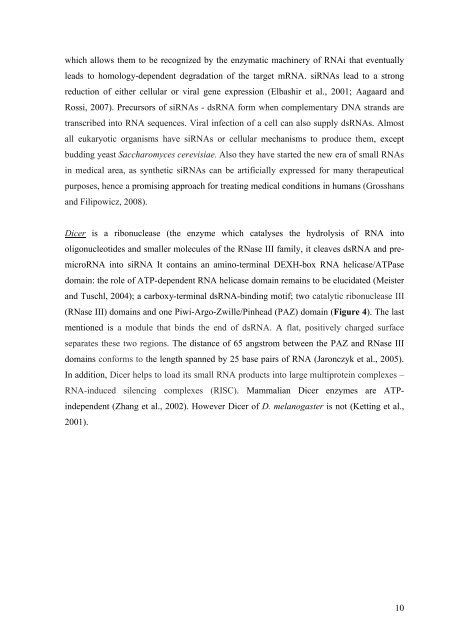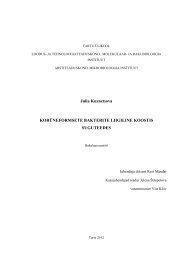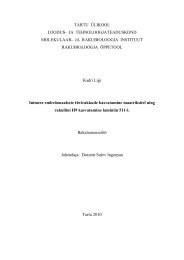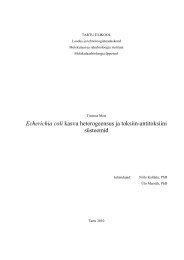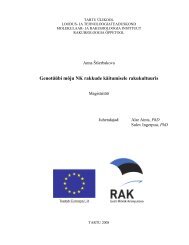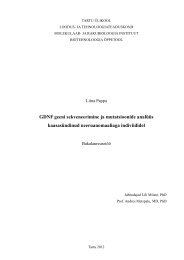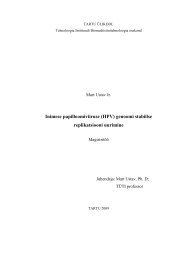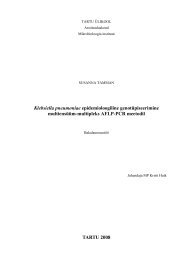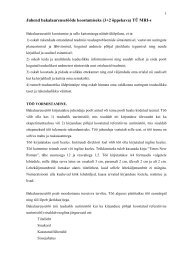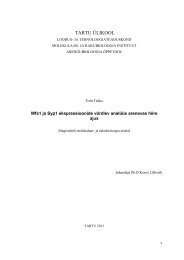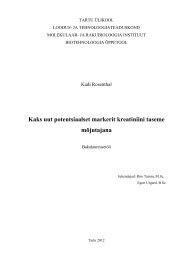Viruses and RNA interference in mammalian cells
Viruses and RNA interference in mammalian cells
Viruses and RNA interference in mammalian cells
You also want an ePaper? Increase the reach of your titles
YUMPU automatically turns print PDFs into web optimized ePapers that Google loves.
which allows them to be recognized by the enzymatic mach<strong>in</strong>ery of <strong>RNA</strong>i that eventually<br />
leads to homology-dependent degradation of the target m<strong>RNA</strong>. si<strong>RNA</strong>s lead to a strong<br />
reduction of either cellular or viral gene expression (Elbashir et al., 2001; Aagaard <strong>and</strong><br />
Rossi, 2007). Precursors of si<strong>RNA</strong>s - ds<strong>RNA</strong> form when complementary DNA str<strong>and</strong>s are<br />
transcribed <strong>in</strong>to <strong>RNA</strong> sequences. Viral <strong>in</strong>fection of a cell can also supply ds<strong>RNA</strong>s. Almost<br />
all eukaryotic organisms have si<strong>RNA</strong>s or cellular mechanisms to produce them, except<br />
budd<strong>in</strong>g yeast Saccharomyces cerevisiae. Also they have started the new era of small <strong>RNA</strong>s<br />
<strong>in</strong> medical area, as synthetic si<strong>RNA</strong>s can be artificially expressed for many therapeutical<br />
purposes, hence a promis<strong>in</strong>g approach for treat<strong>in</strong>g medical conditions <strong>in</strong> humans (Grosshans<br />
<strong>and</strong> Filipowicz, 2008).<br />
Dicer is a ribonuclease (the enzyme which catalyses the hydrolysis of <strong>RNA</strong> <strong>in</strong>to<br />
oligonucleotides <strong>and</strong> smaller molecules of the RNase III family, it cleaves ds<strong>RNA</strong> <strong>and</strong> premicro<strong>RNA</strong><br />
<strong>in</strong>to si<strong>RNA</strong> It conta<strong>in</strong>s an am<strong>in</strong>o-term<strong>in</strong>al DEXH-box <strong>RNA</strong> helicase/ATPase<br />
doma<strong>in</strong>: the role of ATP-dependent <strong>RNA</strong> helicase doma<strong>in</strong> rema<strong>in</strong>s to be elucidated (Meister<br />
<strong>and</strong> Tuschl, 2004); a carboxy-term<strong>in</strong>al ds<strong>RNA</strong>-b<strong>in</strong>d<strong>in</strong>g motif; two catalytic ribonuclease III<br />
(RNase III) doma<strong>in</strong>s <strong>and</strong> one Piwi-Argo-Zwille/P<strong>in</strong>head (PAZ) doma<strong>in</strong> (Figure 4). The last<br />
mentioned is a module that b<strong>in</strong>ds the end of ds<strong>RNA</strong>. A flat, positively charged surface<br />
separates these two regions. The distance of 65 angstrom between the PAZ <strong>and</strong> RNase III<br />
doma<strong>in</strong>s conforms to the length spanned by 25 base pairs of <strong>RNA</strong> (Jaronczyk et al., 2005).<br />
In addition, Dicer helps to load its small <strong>RNA</strong> products <strong>in</strong>to large multiprote<strong>in</strong> complexes –<br />
<strong>RNA</strong>-<strong>in</strong>duced silenc<strong>in</strong>g complexes (RISC). Mammalian Dicer enzymes are ATP<strong>in</strong>dependent<br />
(Zhang et al., 2002). However Dicer of D. melanogaster is not (Kett<strong>in</strong>g et al.,<br />
2001).<br />
10


